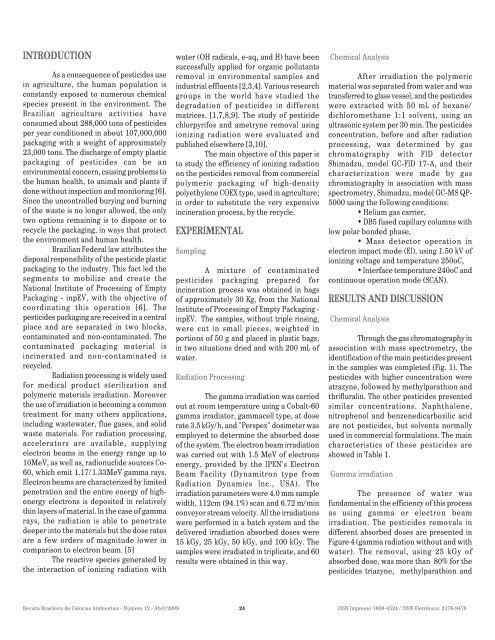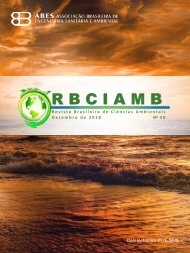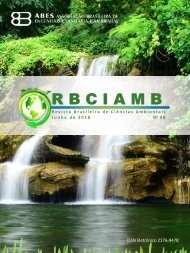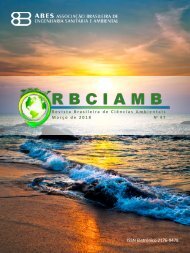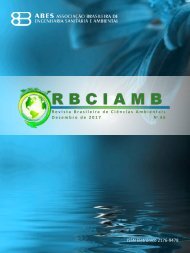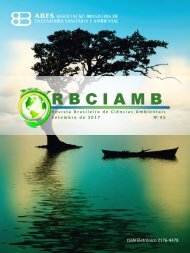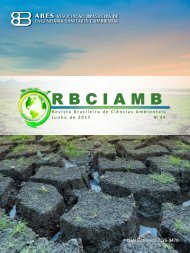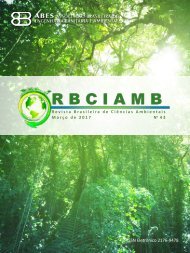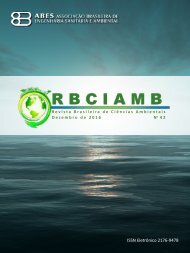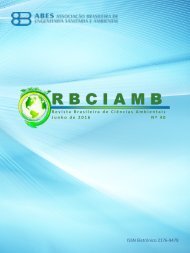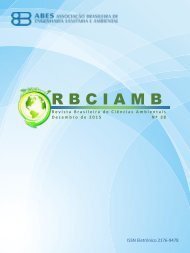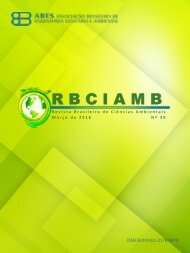EDIÇÃO 12 - Abril/09 - RBCIAMB
A Revista Brasileira de Ciências Ambientais – RBCIAMB - publica artigos completos de trabalhos científicos originais ou trabalhos de revisão com relevância para a área de Ciências Ambientais. A RBCIAMB prioriza artigos com perspectiva interdisciplinar. O foco central da revista é a discussão de problemáticas que se inscrevam na relação sociedade e natureza em sentido amplo, envolvendo aspectos ambientais em processos de desenvolvimento, tecnologias e conservação. A submissão dos trabalhos é de fluxo contínuo.
A Revista Brasileira de Ciências Ambientais – RBCIAMB - publica artigos completos de trabalhos científicos originais ou trabalhos de revisão com relevância para a área de Ciências Ambientais. A RBCIAMB prioriza artigos com perspectiva interdisciplinar. O foco central da revista é a discussão de problemáticas que se inscrevam na relação sociedade e natureza em sentido amplo, envolvendo aspectos ambientais em processos de desenvolvimento, tecnologias e conservação. A submissão dos trabalhos é de fluxo contínuo.
You also want an ePaper? Increase the reach of your titles
YUMPU automatically turns print PDFs into web optimized ePapers that Google loves.
INTRODUCTIONAs a consequence of pesticides usein agriculture, the human population isconstantly exposed to numerous chemicalspecies present in the environment. TheBrazilian agriculture activities haveconsumed about 288,000 tons of pesticidesper year conditioned in about 107,000,000packaging with a weight of approximately23,000 tons. The discharge of empty plasticpackaging of pesticides can be anenvironmental concern, causing problems tothe human health, to animals and plants ifdone without inspection and monitoring [6].Since the uncontrolled burying and burningof the waste is no longer allowed, the onlytwo options remaining is to dispose or torecycle the packaging, in ways that protectthe environment and human health.Brazilian Federal law attributes thedisposal responsibility of the pesticide plasticpackaging to the industry. This fact led thesegments to mobilize and create theNational Institute of Processing of EmptyPackaging - inpEV, with the objective ofcoordinating this operation [6]. Thepesticides packaging are received in a centralplace and are separated in two blocks,contaminated and non-contaminated. Thecontaminated packaging material isincinerated and non-contaminated isrecycled.Radiation processing is widely usedfor medical product sterilization andpolymeric materials irradiation. Moreoverthe use of irradiation is becoming a commontreatment for many others applications,including wastewater, flue gases, and solidwaste materials. For radiation processing,accelerators are available, supplyingelectron beams in the energy range up to10MeV, as well as, radionuclide sources Co-60, which emit 1.17/1.33MeV gamma rays.Electron beams are characterized by limitedpenetration and the entire energy of highenergyelectrons is deposited in relativelythin layers of material. In the case of gammarays, the radiation is able to penetratedeeper into the materials but the dose ratesare a few orders of magnitude lower incomparison to electron beam. [5]The reactive species generated bythe interaction of ionizing radiation withwater (OH radicals, e-aq, and H) have beensuccessfully applied for organic pollutantsremoval in environmental samples andindustrial effluents [2,3,4]. Various researchgroups in the world have studied thedegradation of pesticides in differentmatrices. [1,7,8,9]. The study of pesticidechlorpyrifos and ametryne removal usingionizing radiation were evaluated andpublished elsewhere [3,10].The main objective of this paper isto study the efficiency of ionizing radiationon the pesticides removal from commercialpolymeric packaging of high-densitypolyethylene COEX type, used in agriculture;in order to substitute the very expensiveincineration process, by the recycle.EXPERIMENTALSamplingA mixture of contaminatedpesticides packaging prepared forincineration process was obtained in bagsof approximately 30 Kg, from the NationalInstitute of Processing of Empty Packaging -inpEV. The samples, without triple rinsing,were cut in small pieces, weighted inportions of 50 g and placed in plastic bags,in two situations dried and with 200 mL ofwater.Radiation ProcessingThe gamma irradiation was carriedout at room temperature using a Cobalt-60gamma irradiator, gammacell type, at doserate 3.5 kGy/h, and "Perspex" dosimeter wasemployed to determine the absorbed doseof the system. The electron beam irradiationwas carried out with 1.5 MeV of electronsenergy, provided by the IPEN's ElectronBeam Facility (Dynamitron type fromRadiation Dynamics Inc., USA). Theirradiation parameters were 4.0 mm samplewidth, 1<strong>12</strong>cm (94.1%) scan and 6.72 m/minconveyor stream velocity. All the irradiationswere performed in a batch system and thedelivered irradiation absorbed doses were15 kGy, 25 kGy, 50 kGy, and 100 kGy. Thesamples were irradiated in triplicate, and 60results were obtained in this way.Chemical AnalysisAfter irradiation the polymericmaterial was separated from water and wastransferred to glass vessel, and the pesticideswere extracted with 50 mL of hexane/dichloromethane 1:1 solvent, using anultrasonic system per 30 min. The pesticidesconcentration, before and after radiationprocessing, was determined by gaschromatography with FID detectorShimadzu, model GC-FID 17-A, and theircharacterization were made by gaschromatography in association with massspectrometry, Shimadzu, model GC-MS QP-5000 using the following conditions:• Helium gas carrier,• DB5 fused capillary columns withlow polar bonded phase,• Mass detector operation inelectron impact mode (EI), using 1.50 kV ofionizing voltage and temperature 250oC,• Interface temperature 240oC andcontinuous operation mode (SCAN).RESULTS AND DISCUSSIONChemical AnalysisThrough the gas chromatography inassociation with mass spectrometry, theidentification of the main pesticides presentin the samples was completed (Fig. 1). Thepesticides with higher concentration wereatrazyne, followed by methylparathion andthrifluralin. The other pesticides presentedsimilar concentrations. Naphthalene,nitrophenol and benzenedicarboxilic acidare not pesticides, but solvents normallyused in commercial formulations. The maincharacteristics of these pesticides areshowed in Table 1.Gamma irradiationThe presence of water wasfundamental in the efficiency of this processas using gamma or electron beamirradiation. The pesticides removals indifferent absorbed doses are presented inFigure 4 (gamma radiation without and withwater). The removal, using 25 kGy ofabsorbed dose, was more than 80% for thepesticides triazyne, methylparathion andRevista Brasileira de Ciências Ambientais - Número <strong>12</strong> - <strong>Abril</strong>/20<strong>09</strong> 24 ISSN Impresso 1808-4524 / ISSN Eletrônico: 2176-9478


